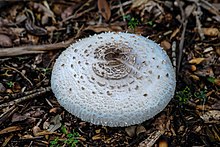
The pileus is the technical name for the cap, or cap-like part, of a basidiocarp or ascocarp (fungal fruiting body) that supports a spore-bearing surface, the hymenium.[1] The hymenium (hymenophore) may consist of lamellae, tubes, or teeth, on the underside of the pileus. A pileus is characteristic of agarics, boletes, some polypores, tooth fungi, and some ascomycetes.
Classification[edit]
Pilei can be formed in various shapes, and the shapes can change over the course of the developmental cycle of a fungus. The most familiar pileus shape is hemispherical or convex. Convex pilei often continue to expand as they mature until they become flat. Many well-known species have a convex pileus, including the button mushroom, various Amanita species and boletes.
Some, such as the parasol mushroom, have distinct bosses or umbos and are described as umbonate. An umbo is a knobby protrusion at the center of the cap. Some fungi, such as chanterelles have a funnel- or trumpet-shaped appearance. In these cases the pileus is termed infundibuliform.
-
Campanulate (bell-shaped)
-
Conical
-
Convex
-
Depressed
-
Flat
-
Infundibuliform
-
Offset
-
Ovate
-
Umbilicate
-
Umbonate
See also[edit]
Notes[edit]
- ^ Moore-Landecker, E: "Fundamentals of the Fungi", page 560. Prentice Hall, 1972.
References[edit]
- Arora, D: "Mushrooms Demystified", Ten Speed Press, 1986.